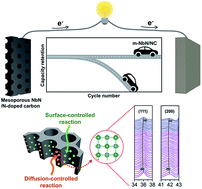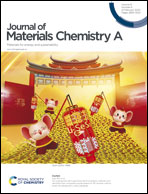A small-strain niobium nitride anode with ordered mesopores for ultra-stable potassium-ion batteries†
Abstract
Lithium-ion batteries (LIBs) are considered as fascinating energy storage devices. However, scarcity and high cost of lithium resources lead to increasing research interest in next-generation batteries, such as potassium-ion batteries (KIBs), due to their similar electrochemical characteristics to LIBs and abundant potassium resources. However, significant problems in the search for suitable anode materials for KIBs continue to exist due to the hazards of potassium metal and unstable cycling performance of carbonaceous materials and metal oxides due to the large ionic size of potassium. Herein, we report on a well-ordered mesoporous niobium nitride/N-doped carbon hybrid (m-NbN/NC), verifying the potential of the transition metal nitride as the new K+ insertion host. The electrode delivers reversible capacities of 143 mA h g−1 at 0.01 A g−1 and 49 mA h g−1 at 1 A g−1. More impressively, a capacity retention of 100% at 0.5 A g−1 after 2000 cycles was achieved. In situ X-ray diffraction and ex situ scanning electron microscopy (SEM) analysis indicated that the m-NbN/NC electrode retains its structural integrity during potassiation that was accompanied by small strain, which was ascribed to the high proportion of surface-controlled reaction. This work points at a feasible new class of anode materials for ultra-stable KIBs.



 Please wait while we load your content...
Please wait while we load your content...